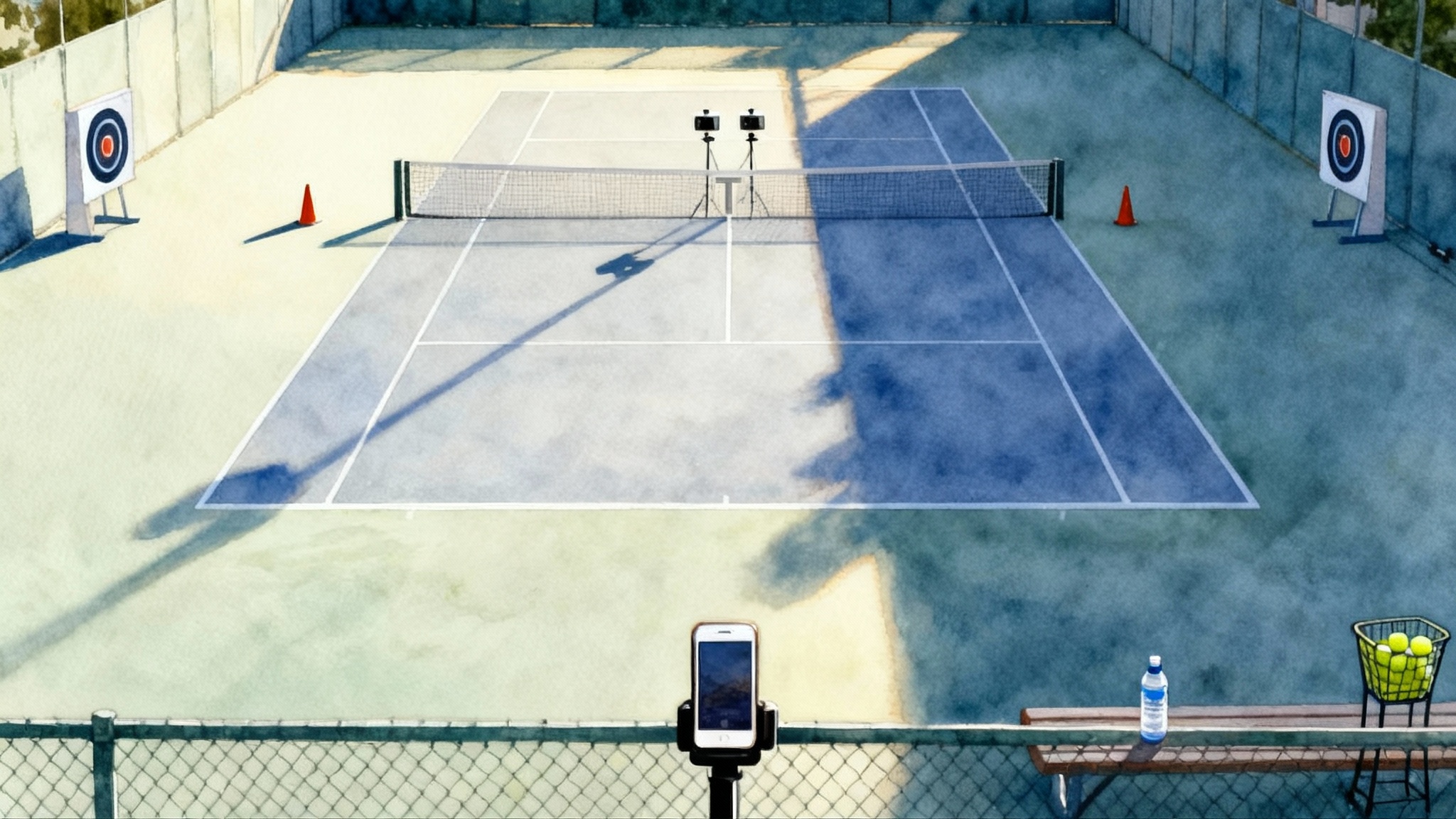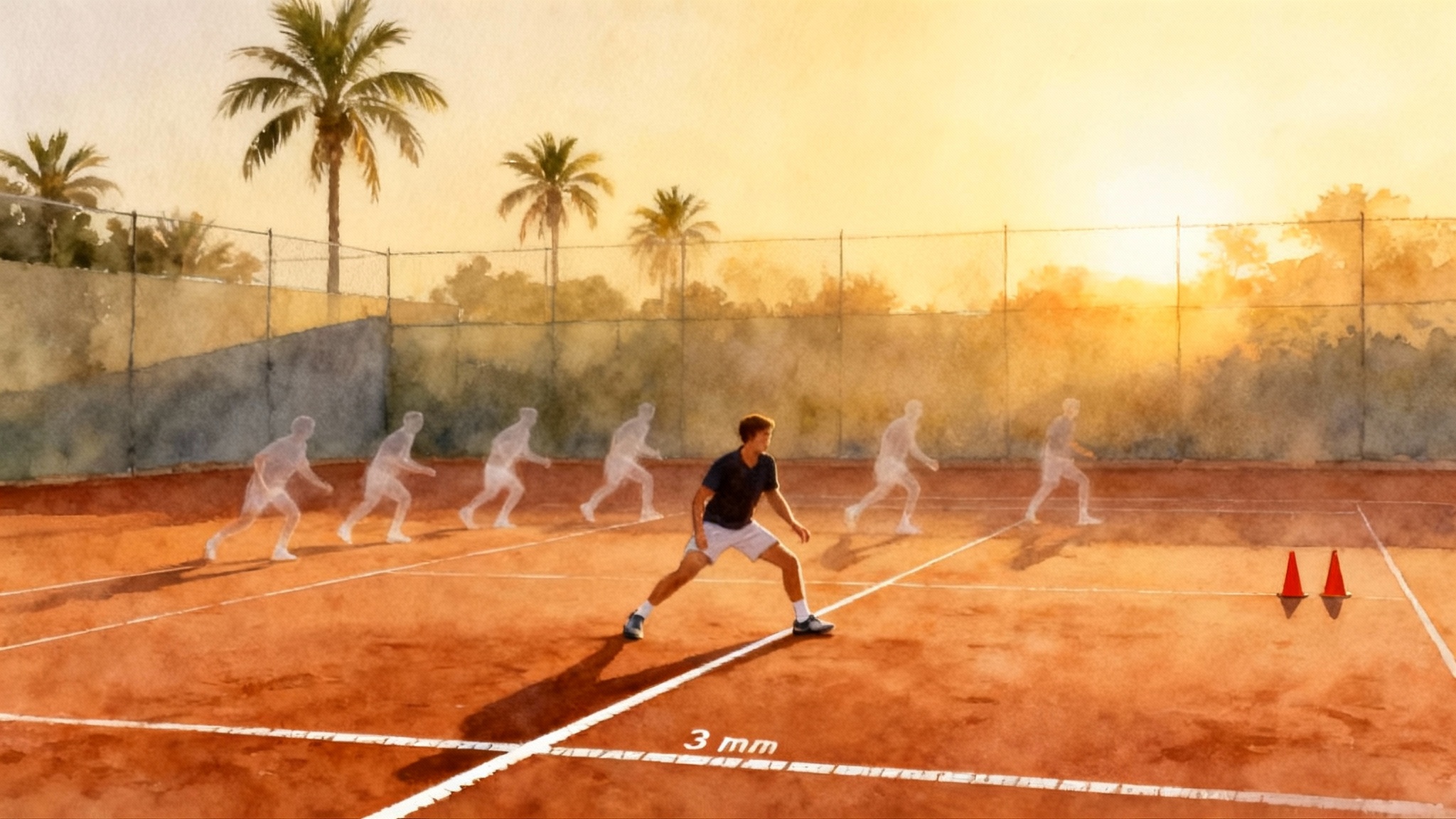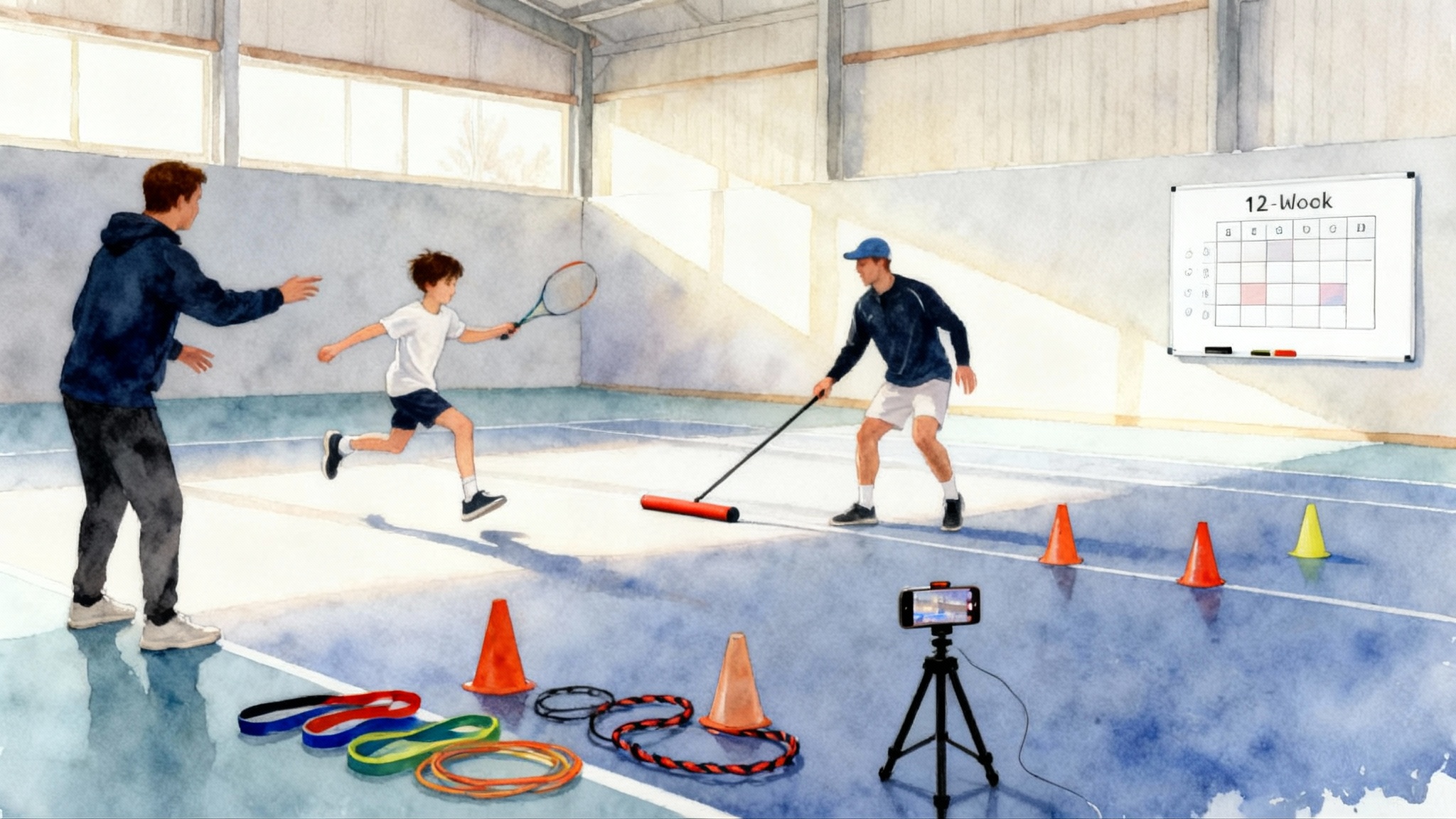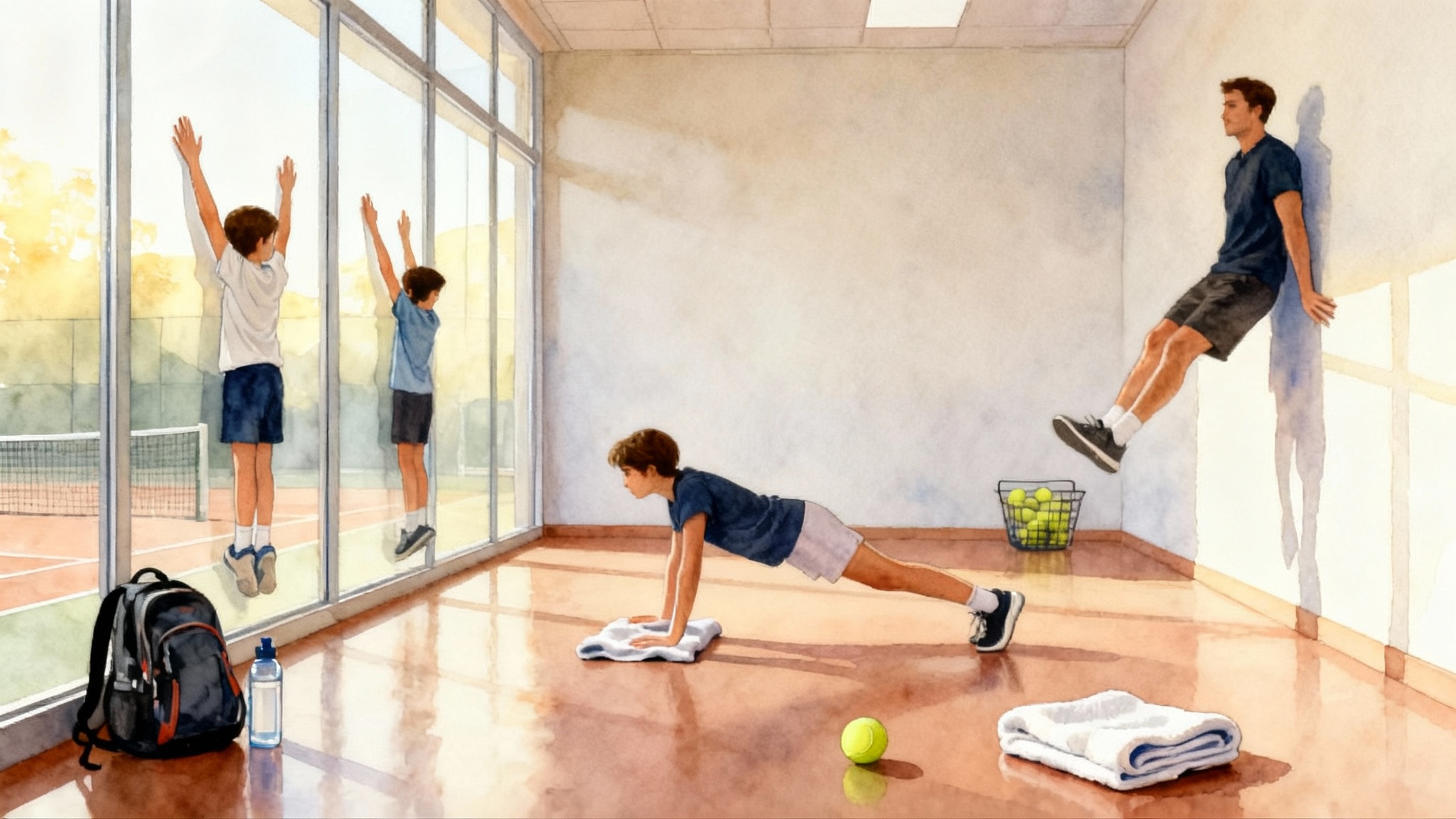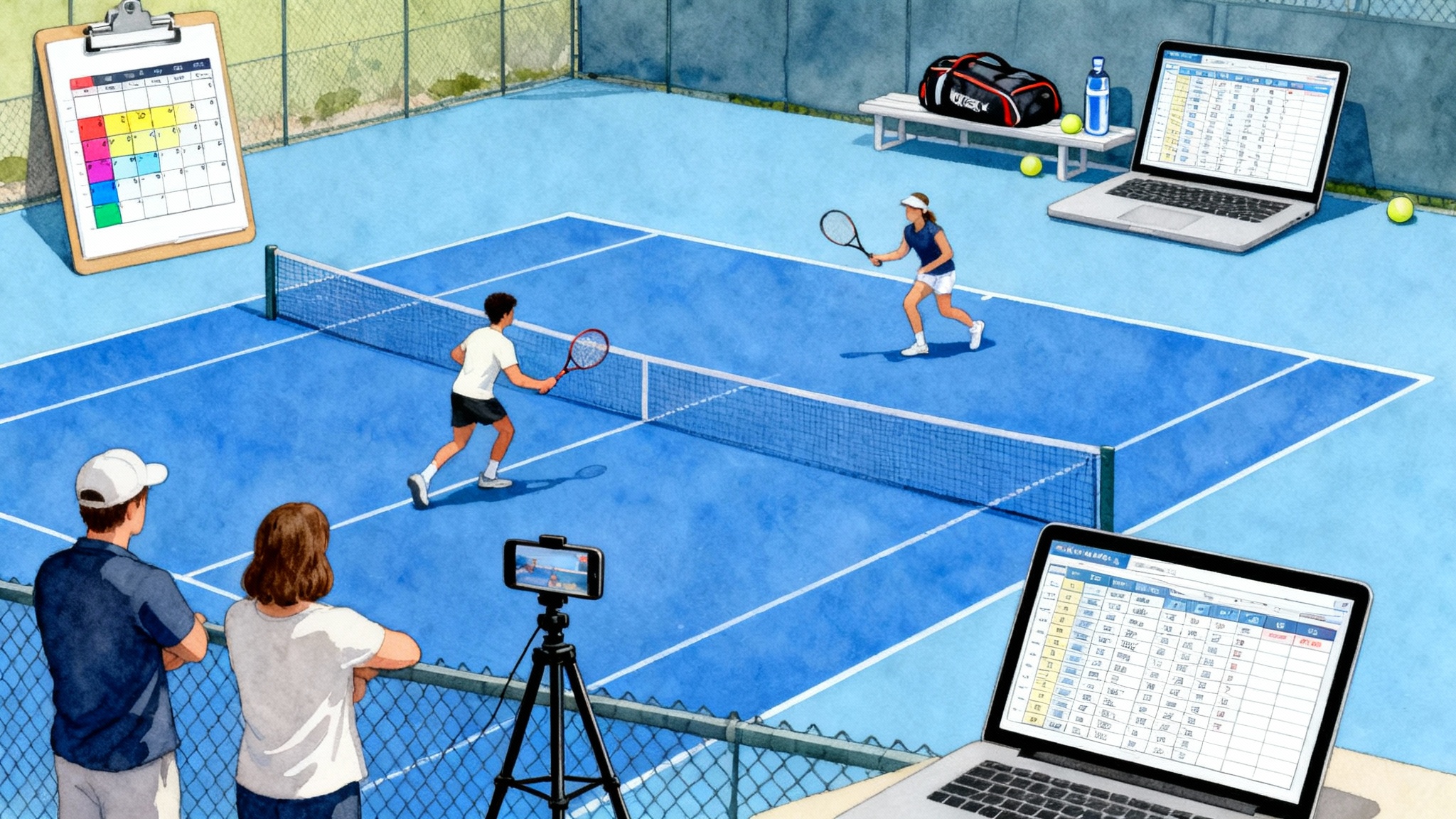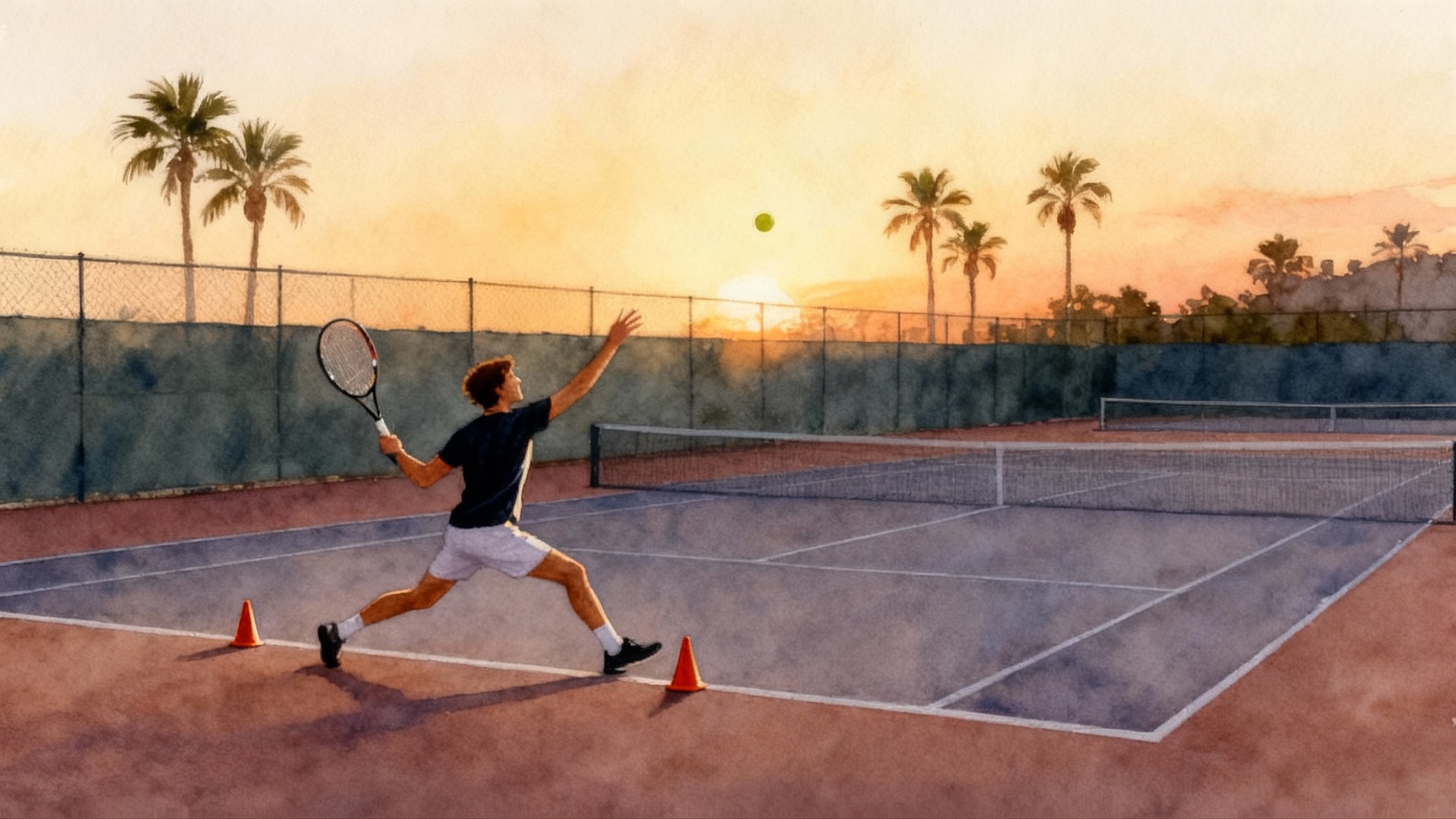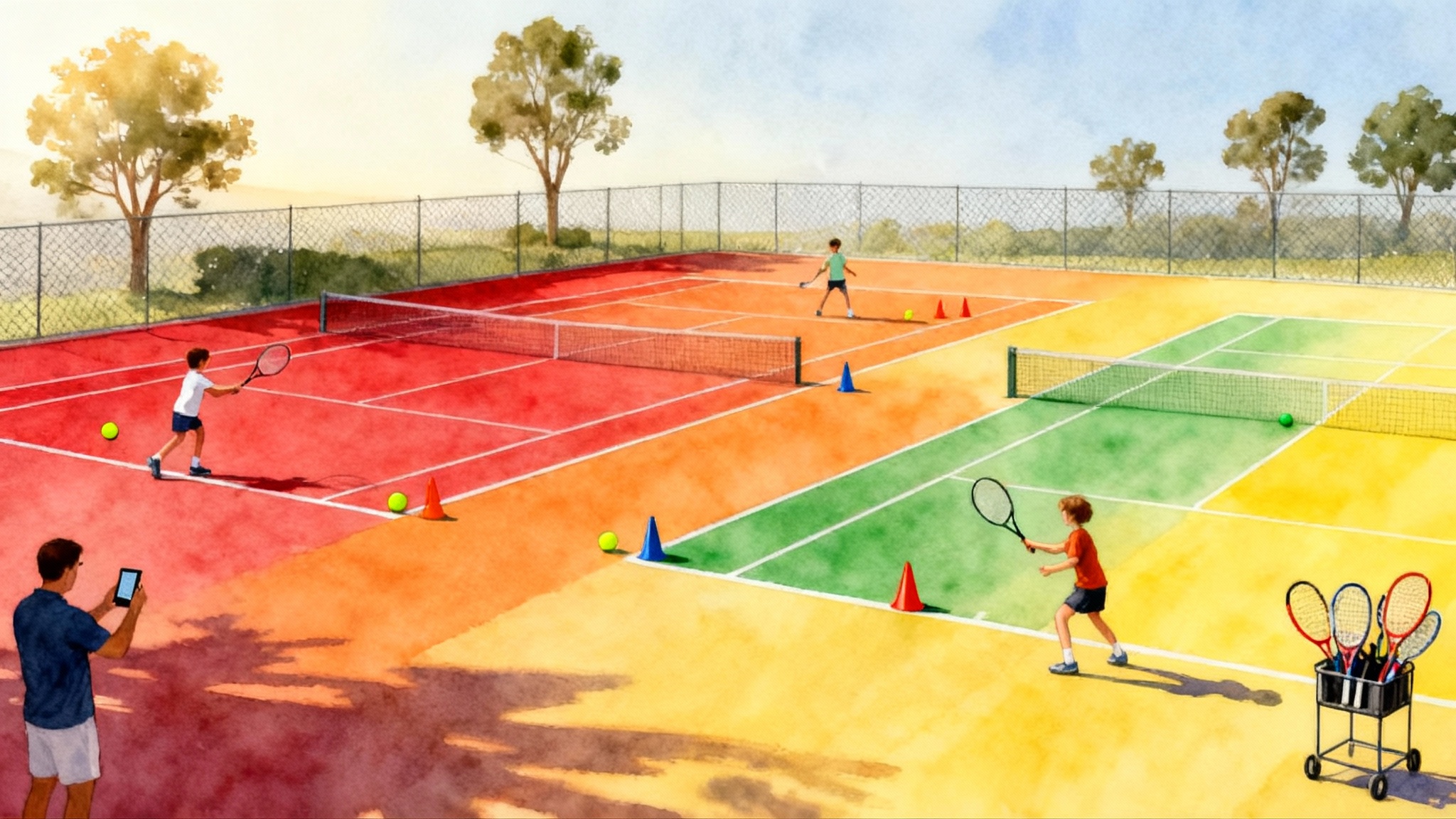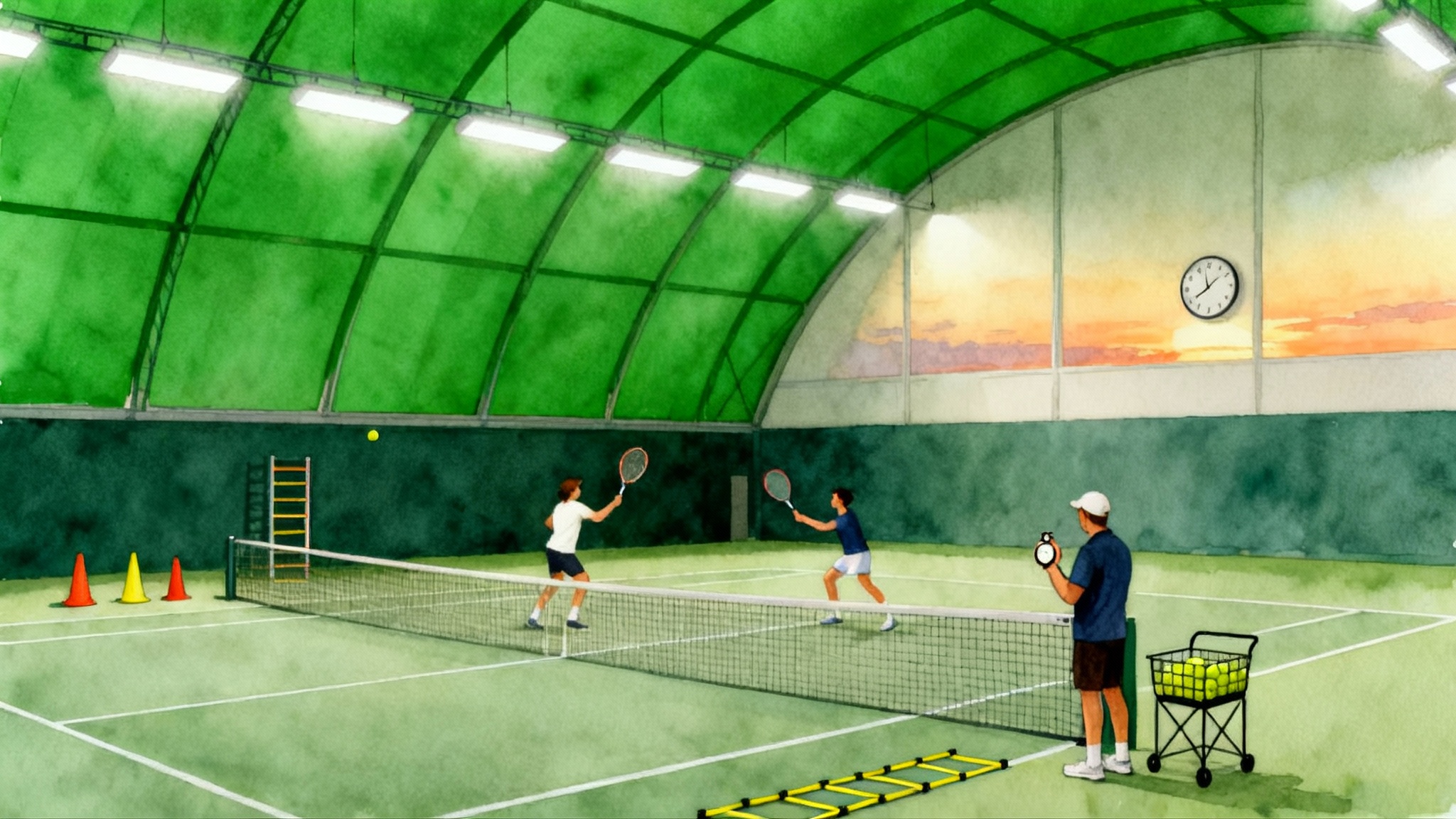Modern Doubles Blueprint: Formations, Signals, Practice Plans
A practical, age-banded guide to doubles. Learn roles, I-formation and Australian setups, clear signals, poach timing, serve plus one patterns, and 60–90 minute practice templates. Includes partner matching, adult fitness blocks, and clinic signposts.
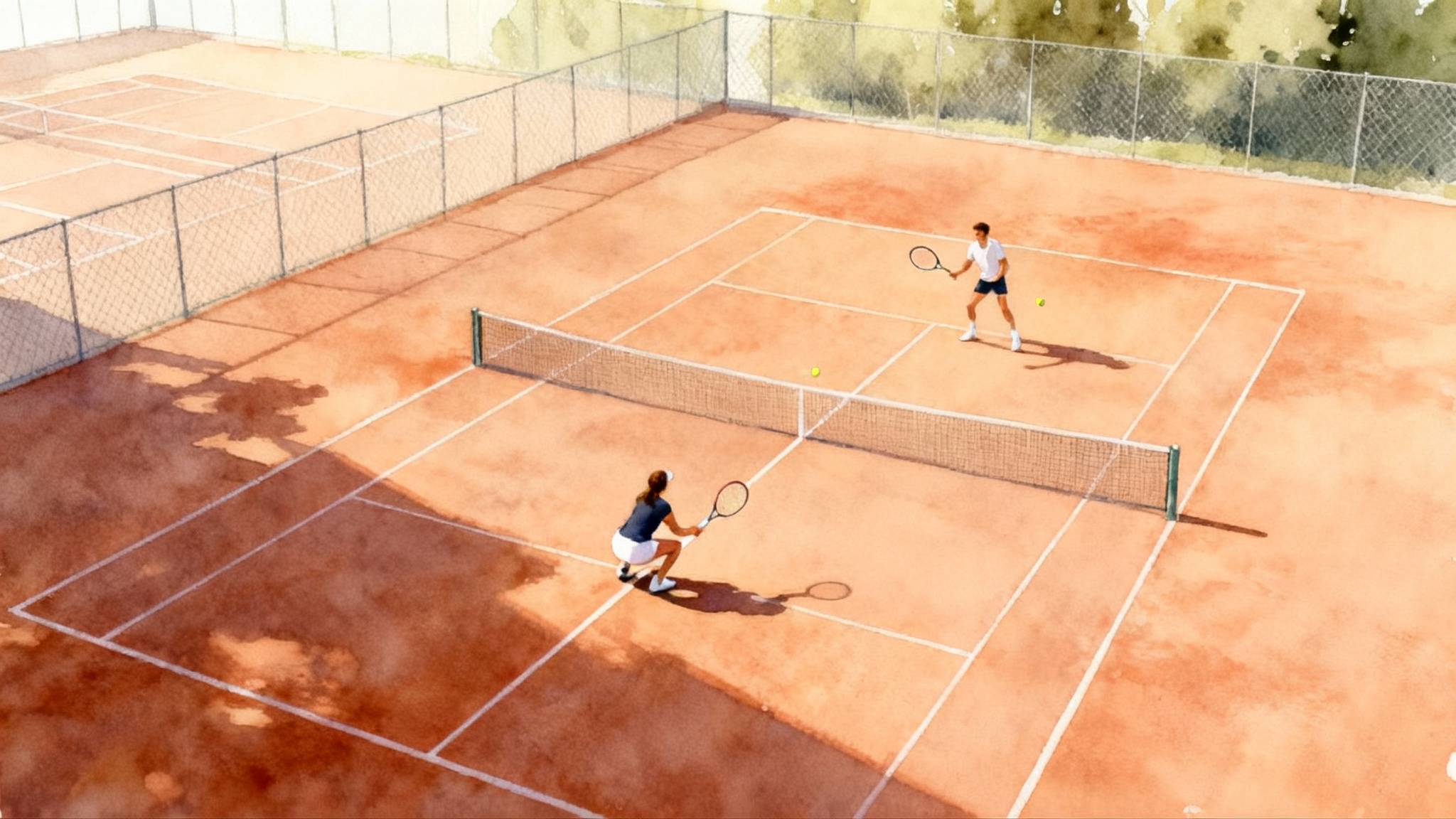
Why doubles skills pay off at every level
Doubles rewards planning, communication, and brave movement. Those are coachable skills, not mysteries reserved for pros. A strong pair changes the math in high school and college dual matches, where coaches prize teams that can bank quick holds and apply pressure on returns. In local leagues and tournaments, strong doubles also lifts your rating and reputation because captains trust pairs who convert close sets and tiebreaks. If you invest one focused session per week, you can upgrade from reactive tennis to intentional patterns that win points in bunches.
If you want guided reps on court, explore the Empire Tennis Academy doubles clinics. What follows is the blueprint those clinics build on, organized by roles, formations, signals, and age-banded practice plans you can run today.
Roles and responsibilities that simplify every point
Think of a doubles point as a four-person project meeting. Everyone has a job, and the outcome improves when each job is clear.
- Server: Start the point with a plan, not just a target. Decide your serve location and the net player’s action before you bounce the ball. The server’s first step after contact is a recover step inside the baseline, then a split step keyed to the returner’s swing. For deeper work, see our return of serve reads and split timing.
- Server’s net player: Drive the point. Your first duty is to read the returner. Your second duty is to cut the middle with your feet and racket ready. You make the team dangerous.
- Returner: Choose a high percentage lane that denies the net player. Deep crosscourt is the default. Change the rhythm with a firm chip down the line only when you see the server’s partner leaning.
- Returner’s partner: Shadow the server’s net player. If they close, you close. If they fake, you hold position and look to counter the middle. Your voice keeps the returner calm and decisive.
Small communications that matter:
- Call “mine” or “yours” early. Do not wait until the ball lands.
- Use one cue word per ball state: “bounce” for lobs, “drive” for hard low balls, “up” when you are coming forward.
The core formations: standard, I-formation, Australian
You only need three formations to feel modern and unpredictable.
Standard formation
- Setup: Server starts near the singles sideline on deuce or ad. Server’s partner sets up two racket lengths from the net, just inside the service box centerline.
- Purpose: Ownership of the middle and highest margin targets. Use this by default until the returner proves too comfortable.
I-formation
- Setup: Server stands near the center mark. Server’s partner crouches on or just behind the service line, almost on the centerline, signaling behind the back.
- Purpose: Hide your net player’s starting side. Force the returner to guess or play to narrower angles. Great when the returner is crushing crosscourt returns.
- Key details: The net player pops up and moves to the called side after the serve clears the net. The server slides the opposite direction to cover the open half. The crouch keeps you out of the returner’s direct line of sight.
Australian formation
- Setup: Both server and net player start on the same side of the centerline, for example both on the deuce half.
- Purpose: Bait the returner down the line or funnel play into your forehand middle. Great when the returner has a weak down-the-line drive or when you want to take away their favorite crosscourt window.
- Key details: The server must serve wide enough to jam the returner’s contact and then sprint to cover the other half if needed. The net player protects the line until the ball passes, then shifts to the center to own the next shot.
Simple hand signals that work under pressure
Signals keep your plan quiet and your actions synchronized. Use them any time the server’s partner is at the net. Hide the signaling hand behind your back so the return team cannot see it.
- Closed fist: Poach. You will cross to intercept the return.
- Open hand: Stay. You will hold your side after the serve.
- Pinky finger: Poach and switch. You cross and stay on the new side.
- Thumb to the line: Protect the line. You will start close and guard against the down-the-line return.
- Index finger to the middle: Pinch the middle. You start central and look to volley through the center seam.
Add a second signal for serve location so the server can aim with confidence.
- One finger low: Serve to the body.
- Two fingers low: Serve to the T.
- Three fingers low: Serve wide.
Sequence your plan in this order: action first, then location. For example, closed fist plus two fingers means poach on a serve to the T.
Poach timing made simple
Poaching is not a leap of faith. It is a series of small reads and steps.
- Read the returner’s contact height. High contact often goes crosscourt with pace, which is poach friendly. Low, late contact tends to float. That is also poach friendly.
- Start with a soft preload. Shift your split step one shoe length toward the middle just before the returner swings.
- Move on the server’s ball bounce and the returner’s forward swing, not after the ball crosses the net. A clean poach often starts as the returner meets the ball, which makes your first step decisive and early.
- Cross with the outside leg, keep the racket head high, and volley through the middle third. Do not aim for sidelines unless the ball sits up.
If you are late, fake it. Show a step, recover to your side, and make the returner aim small. A good fake today buys you a free poach tomorrow. For movement refreshers, review footwork patterns from split step to shuffle.
Serve plus one patterns that hold and break
Doubles points are short. Build two-shot stories that repeat.
For the serving team:
- Body serve plus middle volley: Serve at the returner’s hips, your net player pinches, and you aim the first volley through the low middle. This blunts big swings and draws errors.
- T serve plus poach: Aim up the T, which shortens the angle. Your net player crosses and targets the opposite service box. The server follows behind to cover the vacated half.
- Wide serve plus server’s first ball to the open court: Drag the returner off court with a wide serve. Expect a crosscourt reply. The server’s first groundstroke goes to the largest empty space and the net player guards the line.
For the returning team:
- Deep crosscourt return plus partner close: Drive the return deep crosscourt and call your partner forward to the service line. Own the middle and raise the volley-to-volley pressure.
- Chip return down the line when the net player leans: Use this sparingly. If you see the server’s partner over-committing, carve the ball down the line and follow it to the net.
- Lob return over an aggressive net player: If the server’s partner is poaching early, float a neutral lob over their head. Step in as a team and finish with the overhead from the middle.
Partner matching for juniors
Junior pairs often get formed by convenience, not by fit. Match for complementary roles and shared habits.
- Combine a reliable server with a bold net mover. The server’s consistency sets the table, the mover eats.
- Pair a heavy topspin baseliner with a crisp volleyer. One sets up, one finishes.
- Consider hand dominance. A righty and a lefty often control the middle with two forehands, which discourages lobs and rewards poaches.
- Match energy styles. Two hyper players can rush decisions. Two quiet players can hesitate. One vocal leader plus one cool executor is a winning mix.
- Set tiny rituals. Two deep breaths before each point, a quick fist tap after errors, and one clear call word for each play. Rituals make new pairs feel like old friends.
Parents can help by keeping stats for one match: first serve percentage, return depth that clears the service line, and middle-ball conversion rate. Track again two weeks later. Juniors respond to visible progress.
Age-banded weekly practice templates
Each plan runs 60 to 90 minutes. Use the shorter duration for busy school weeks and the longer duration when time allows.
Juniors 10 to 14
- 10 minutes: Dynamic warm up with mini tennis. Forehand and backhand only inside the service boxes, then add volleys and overhead shadows.
- 12 minutes: Target serving. Two minutes per target, rotating body, T, and wide. Net player holds a cone in the intended lane as a visual cue.
- 15 minutes: Return plus one live. Coach or parent serves. Returner aims deep crosscourt. Partner calls one of three actions before each serve: hold, pinch, or poach. Keep simple scoring, first to 11 by twos.
- 15 minutes: I-formation basics. Net player crouch, one simple signal for stay or poach. Serve only to the T. Switch server and repeat.
- 8 minutes: Australian formation challenge. Both players start same side. Serve wide, returner tries to go down the line, server’s partner protects. Rotate sides.
- 10 to 20 minutes: Compete. First to 15 points, standard formation, bonus point for any clean poach or successful lob return that leads to a win.
High school 15 to 18
- 10 minutes: Warm up with drive-volley exchanges. Two players at baseline, two at service line. Feed low drives, volleyers keep the ball through the middle.
- 12 minutes: Serve plus one patterns. Three balls per point. Pattern A: body serve, middle volley. Pattern B: T serve, poach. Pattern C: wide serve, server’s next ball to open court. Score one point only if the team executes the called pattern.
- 15 minutes: Poach timing ladder. Coach feeds returns from a basket. Net player must cross on a call of “green,” fake on “yellow,” hold on “red.” Rotate every four balls.
- 15 minutes: Australian pressure set. First to 7 points, must start every point in Australian. Switch sides and repeat.
- 8 minutes: Second serve breaker. Servers only hit second serves. Return team must come forward on any short ball. Score two points for a successful poach off a second serve.
- 10 to 20 minutes: Tiebreak simulation. First to 10. Coach calls formation each point. Players signal action. Debrief for two minutes on what felt automatic and what did not.
Adults and parents 18 and up
- 8 minutes: Warm up with service line volleys, then half-court overheads. Focus on balance and a quiet head.
- 12 minutes: Serve targets with signals. Net player gives action plus location. Each server hits 12 balls per target. Track first serve percentage and target accuracy.
- 15 minutes: Return games. Returner must choose deep cross, short angle, or defensive lob before the serve. Partner mirrors the choice with movement and voice. First to 11 by twos.
- 15 minutes: I-formation decision tree. Crouch, signal stay or poach plus serve to T. If the return beats you down the line twice, switch to Australian for the next three points.
- 10 minutes: Middle owns the money. Play points starting with a coach feed to the center. Only balls that land inside the singles sticks count. This trains seam awareness and discourages low percentage sidelines.
- 10 to 20 minutes: Matchplay with constraints. Earn double points for any rally won at the net. This shifts habits toward forward movement.
Add-on court fitness blocks for adults
Keep these on-court circuits to 10 to 15 minutes after practice. They build the legs, posture, and reaction speed that make poaches feel easy.
- Split step ladder: Six rungs forward, split, shuffle left two, shuffle right two, recover. Three sets.
- Baseline to service line sprints: Five sprints, focus on lowering center of gravity for the last three steps.
- Med ball rotational tosses: Ten per side from the service line to the back fence. If no med ball, shadow the move with a racket and pause at full torso rotation.
- Reactive volleys: Partner tosses rapid forehand and backhand volleys for 30 seconds, 15 seconds rest, three rounds. Keep the head still and the racket above the wrist.
Coaching the signals in two minutes or less
If you coach juniors or adult teams, teach the entire signal system in two minutes at the net.
- Show the four action signals behind your back: poach, stay, fake, switch. Pick only two for today.
- Show the serve location signals: body, T, wide. Pick one today.
- Rehearse three silent reps. Server bounces, both players peek, call the score, serve, execute. No speaking until the point ends.
- Add voice only after the ball crosses the net. Short words win. “Up,” “line,” “mine.”
Resist the urge to add more codes. Simplicity speeds decision making, which frees you to read the ball.
Common mistakes and fast fixes
- Static net player: If your feet are nailed to the court, you look easy to hit around. Fix by taking a tiny hop just before every opponent contact and shifting one shoe length toward the middle.
- Serving with no plan: If you bounce and blast, your partner is guessing. Fix with signals and a single serve location per point.
- Watching winners: Many teams admire a good return or first volley. Fix by calling out the next ball before you hit the current one. Say “middle” or “line” out loud as you strike.
- Over-lobbing: Lobs have value, but short lobs concede the net. Fix by practicing the defensive lob with a higher window over the service line, and by pairing lobs with forward movement to finish.
- Ignoring the seam: Singles players love sidelines. Doubles rewards the gap between opponents. Fix by drawing a chalk line down the middle in practice and aiming through it.
How strong doubles boosts lineup value and ratings
High school and college coaches look for pairs who can win the swing points: break points, sudden-death deuce, and early tiebreaks. Efficient formations and signals convert those moments because they reduce hesitation. In local leagues that use the National Tennis Rating Program, wins in doubles against established rated players can move your numerical rating up over a season. Captains also tend to place reliable pairs on courts that decide the tie, which increases your exposure to higher rated opponents. In short, better patterns create better matchups, which turn into better results.
A four week progression you can repeat all season
Week 1: Standard formation and deep crosscourt discipline
- Goal: Win the middle with safe margins.
- Focus: Serve plus one through the center, return crosscourt 80 percent of the time.
Week 2: Add I-formation on 30 percent of serves
- Goal: Disrupt return rhythms.
- Focus: Two signals only, stay or poach. Serve to the T.
Week 3: Introduce Australian on the ad side
- Goal: Bait the down the line return and protect it.
- Focus: Net player holds the line until the ball crosses, then shifts middle.
Week 4: Poach timing and fake variety
- Goal: Own the first four shots.
- Focus: Three fakes per game and at least one real poach per service game.
After week 4, cycle back to week 1 with slightly tougher scoring. For example, require a first serve in to start the point, or award bonus points for any successful poach on a big point.
On-court sharpening with Empire Tennis Academy
All of this becomes easier with professional eyes and live feeding patterns. If you are in the region, book a spot in the Empire Tennis Academy doubles clinics. Sessions cover formation choice, signal clarity, and movement timing, and you will get instant feedback on your poach energy and recovery steps.
Your next step
Pick one formation, one serve target, and one action signal for your very next match. Tell your partner at the fence, then stick with the plan for three service games before you change anything. Add one simple return play for your receiving games. Keep the language short, the moves early, and the targets through the middle. Doubles rewards clarity. When you simplify the plan, you speed up your feet and free up your swing. That is how a weekly 60 to 90 minute session becomes real scoreboard pressure, better lineup value, and results you can feel in every tiebreak you play.
